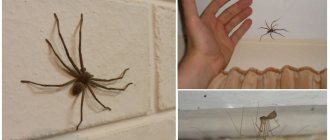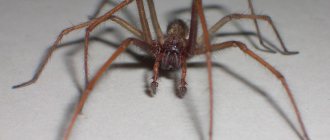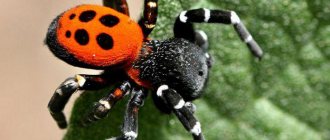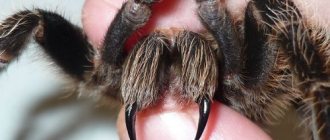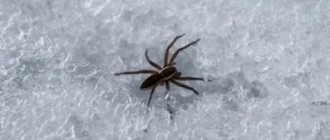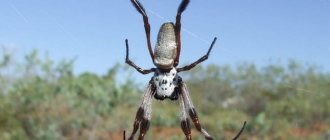Spiders of Belarus are not aware of state borders and their species set is the same: on the eastern side, the diversity of arthropods living in Russia; from the west – the composition of arachnids in Ukraine and Poland. Arachnology in Belarus is in a deplorable state. Even the number of species living there is not known for certain. According to various sources, the number of species ranges from 209 to 500. With further study, the number of arachnids is guaranteed to increase.
Types of spiders in Belarus
Since nearly 40% of the territory of Belarus is occupied by forests and swamps, and another 20% by grassy areas, the main part of the arachnofauna here is made up of forest and meadow spiders. Among the arthropods found in Belarus, there are 29 families:
- Diggers;
- Funeral;
- Haymakers;
- Brownies;
- Funnel;
- Orb weavers;
- Pygmies;
- Linifidae;
- Tenetniki;
- Tetranides;
- Anifanids;
- Cibeids;
- Dictinids;
- Khanids;
- Corinids;
- Liocranian marsupials;
- Earthen;
- Wolves;
- Oxypides;
- Hunters;
- Zorids;
- Pirates;
- Horses;
- Sparassids;
- Philodromidae;
- Sidewalkers (aka “crabs”);
- Titanosides;
- Clubionidae;
- Miturgids.
Some of these families in Belarus contain only one species, others - up to 10. The last family includes two species of Heiracanthiums. These two spiders have nothing to do with their southern counterpart. They are much smaller than yellow heyracantium and are not dangerous to humans.
On a note!
Only the silver spider can be considered a poisonous spider in Belarus.
Serebryanka
Spider from the Cybaid family. In Belarus, this family is represented only by silverfish. The second name of this species is water spider. Silver grass is widespread in Europe. Lives in bodies of water with stagnant or slow-flowing water. Catches small crustaceans swimming underwater.
Silver spider
It also spins a web underwater, using it as a diving bell for breathing. The thick stubble on its abdomen, which does not get wet, allows it to store air in its bell-shaped shelter. When the spider dives, air remains between the bristles, which the silverfish “cleans” from the abdomen into the shelter.
It overwinters underwater using the shells of dead mollusks. The silverfish attaches its air-filled shells to the duckweed. After the duckweed sinks to the bottom of the reservoir for the winter, it will drag the shell with it.
Interesting!
During hibernation, the silverfish's metabolism is greatly slowed down and there is enough air in its shell to survive the winter.
In terms of the strength of its poison, silverfish is inferior to karakurt and steatode, but it is also capable of delivering very unpleasant sensations for several hours. The spider can bite through the skin of a person in the water.
A village in the Gomel region was attacked by large tarantula spiders (video)
Large spiders attacked the Gomel region. The problem is back! This time the insects encircled the village of Udarnoye, Lelchitsy district.
Residents meet them in their gardens, barns, and today one of these uninvited guests even snuck into the house!
Akin to a horror movie script. But seriously, eyewitnesses describe the tarantulas themselves as aggressive insects that are not afraid to attack. Maxim Vecherkov went on a dangerous business trip.
It was a fight, says Nadezhda . Seeing a huge shaggy spider approaching the baby's crib, she took the firecracker. But the guest did not even think about hiding - he began to jump sharply towards him.
The woman sounded the alarm. And you didn’t even have to show proof at the bank - just a day later the same spider made its way into the local school. Teachers immediately noticed the size and unusual color.
Situations began to repeat themselves as if they were carbon copies. Spiders were seen at a local medical center, then in a store, and at a construction site. In the village the only talk is about the insect invasion. And this is the second part of the story about tarantulas.
This is 150 kilometers from Udarny. According to experts, the spiders may have been accidentally transported with cargo.
Scientists confirm that this is a real South Russian tarantula. Can reach the size of a human palm. The species itself, although rare, is still found in our southeast. And due to climate warming, their habitat is expanding and their activity is increasing.
The tarantulas most likely come from the forest. It's literally 200 meters away. Although, by their nature, due to sensitivity to any vibrations, they should be very timid: sit in burrows and lead a hidden lifestyle. But, apparently, something went wrong - these, on the contrary, are too brave.
Scientists do not know what brought them to the village and why spiders approach humans. But such behavior, they say, is truly unnatural. They urge you not to panic and stay on the defensive.
Nikolai Galinovsky , entomologist, candidate of biological sciences: “One of the methods is treatment with repellent agents or ultrasound, as is the case with an ultrasound installation for cockroaches, in a socket, you can try for spiders.” And if the situation suddenly gets out of control, the regional center will have to be involved. The village authorities say that the problem cannot be solved on their own.
Mikhail Bovsunovsky , Chairman of the Udarnensky Rural Executive Committee: “Of course, we will attract those specialists who are necessary, if these are really spiders, and even dangerous, poisonous ones, of course, measures will be taken - this is not a joke.”
Spiders are poisonous. But with a caveat. The impact on humans can be compared to the bite of a hornet. It is not fatal, but in some cases, however, a severe allergic reaction may occur. In general, there are more than ten species of large spiders that can bite through human skin in Belarus. And not all of them are harmless.
Now in Udarny, volunteers are combing the surrounding area in small groups. They are looking for nests that have begun to appear in residential areas, near the first floors of apartment buildings. For now, spiders are simply caught with bait and locked in a jar to be shown to scientists later.
Conditionally dangerous
These are the large spiders of Belarus from the orb weavers: Argiope Brünnich and the cross spider. The most dangerous of them is argiope, as its bite causes quite severe pain. The cross spider is considered a dangerous spider, but in reality it is not capable of biting through the skin. Fears of this species are caused by the size of the animal, although even from the photo and description the argiope should cause more concern. Bright warning coloring is usually characteristic of animals that are able to protect themselves. The female Argiope has exactly this coloration. Because of this, the animal received the nickname - wasp spider.
The cross and argiope live in similar conditions:
- parks;
- gardens;
- forest edges.
These spiders live at mid-levels and build webs on bushes and tall stems of grass.
Spiders of Belarus
Diggers
In Belarus, this type of spider is represented by one species. They are also called “atypical tarantulas” or calque from Latin - atipus. Atipuses have nothing to do with real tarantulas, neither in the Russian nor in the English sense of the word.
On a note!
Mizgir, aka the South Russian Tarantula, does not live in Belarus.
The venom of atipus is weak, but they have long chelicerae with which they can bite through the skin. These spiders live in a colony. Individually they are not aggressive, but if the colony is threatened they can attack. In this case, multiple spider bites will cause harm.
BrestCITY. News
Large spiders attacked the Gomel region. This time the insects encircled the village of Udarnoye, Lelchitsy district.
Residents meet them in their gardens, barns, and today one of these uninvited guests even snuck into the house!
Akin to a horror movie script. But seriously, eyewitnesses describe the tarantulas themselves as aggressive insects that are not afraid to attack. Maxim Vecherkov went on a dangerous business trip.
It was a fight, Nadezhda says. Seeing a huge shaggy spider approaching the baby's crib, she took the firecracker. But the guest did not even think about hiding - he began to jump sharply towards him.
The woman sounded the alarm. And you didn’t even have to show proof at the bank - just a day later the same spider made its way into the local school. Teachers immediately noticed the size and unusual color.
Situations began to repeat themselves as if they were carbon copies. Spiders were seen at a local medical center, then in a store, and at a construction site. In the village the only talk is about the insect invasion. And this is the second part of the story about tarantulas.
This is 150 kilometers from Udarny. According to experts, the spiders may have been accidentally transported with cargo.
Scientists confirm that this is a real South Russian tarantula. Can reach the size of a human palm. The species itself, although rare, is still found in our southeast. And due to climate warming, their habitat is expanding and their activity is increasing.
The tarantulas most likely come from the forest. It's literally 200 meters away. Although, by their nature, due to sensitivity to any vibrations, they should be very timid: sit in burrows and lead a hidden lifestyle. But, apparently, something went wrong - these, on the contrary, are too brave.
Scientists do not know what brought them to the village and why spiders approach humans. But such behavior, they say, is truly unnatural. They urge you not to panic and stay on the defensive.
Nikolai Galinovsky, entomologist, candidate of biological sciences: “One of the methods is treatment with repellent agents or ultrasound, as is the case for cockroaches using an ultrasound device in a socket, you can try for spiders.”
And if the situation suddenly gets out of control, the regional center will have to be involved. The village authorities say that the problem cannot be solved on their own.
Mikhail Bovsunovsky, Chairman of the Udarnensky Rural Executive Committee: “Of course, we will attract those specialists who are necessary, if these are really spiders, and even dangerous, poisonous ones, of course, measures will be taken - this is not a joke.”
Spiders are poisonous. But with a caveat. The impact on humans can be compared to the bite of a hornet. It is not fatal, but in some cases, however, a severe allergic reaction may occur. In general, there are more than ten species of large spiders that can bite through human skin in Belarus. And not all of them are harmless.
Now in Udarny, volunteers are combing the surrounding area in small groups. They are looking for nests that have begun to appear in residential areas, near the first floors of apartment buildings. For now, spiders are simply caught with bait and locked in a jar to be shown to scientists later.
Source of information: ONT.
09.22.2018.
News on the topic: animals Views: Subscribe to Brest News in Google Read BrestCITY in Yandex.News ———————-
Harmless
The following families are very common in Belarus: funnelbirds, hunters, sidewalkers and horses. Besides them, you can find 4 species of wolf spiders there. Apart from family and protective coloration, these night hunters have nothing in common with the South Russian tarantula, which is also a wolf spider.
Funnel
Funnelfish live in moist, shaded places, on the forest floor, under snags and at the foot of bushes. They often settle in village houses. People gravitate toward human habitation:
- funeral;
- brownies;
- attics.
Interesting!
All these spiders build shelters in the form of funnels. They hunt woodlice, small invertebrates, and insects. In a country house, these species bring considerable benefits.
Hunters
They live on the banks of reservoirs, of which there are plenty in Belarus. There are only 3 pisaurid spiders found in the country. Spiders hunt with their hind legs on coastal vegetation and their front legs on the water surface. These hunting spiders can glide across the surface of a body of water like water striders.
On a note!
One of the pasaurids, a large alloy spider, is included in the Red Book of Belarus.
Expert commentary. Where does the South Russian tarantula come from in Belarus? It's been here since the 19th century!
The news about the appearance of a poisonous tarantula in the south of the republic caused excitement in Bynet. In the village of Udarnoye, Lelchitsy district, these large spiders were seen in vegetable gardens, sheds, a local first-aid post, a store, a construction site and a school. Scientists have confirmed that this is a real South Russian tarantula, and the local population believes that the spider came to them from the forest.
10/01/2018 Living nature Aўtar: Evgenia Pestunova Photo: group “Ranak” in VK
Anatoly Kulak, leading researcher at the laboratory of terrestrial invertebrates at the Scientific and Production Center for Bioresources of the Academy of Sciences of Belarus, told BLG where tarantulas come from in our latitudes and what danger they pose .
— South Russian tarantulas have been periodically observed in Belarus and may well be typical of our southeastern warm and dry regions, although most people believe that they are not typical for our country. Why not? According to literary data, the South Russian tarantula has been known in Belarus since the 19th century. According to climatic conditions, the species is most common in the southeast of Belarus. Spiders began to actively spread throughout Belarus, using the floodplains of the Pripyat, Dnieper and Sozh rivers as ecological corridors. The South Russian tarantula is an insect whose body length can reach 3.5 cm. South Russian tarantulas do not live in forests, as some people think. This species prefers more open landscapes; it digs burrows, so it chooses areas with fairly loose soil. Tarantulas prefer swampy meadows, live near water and feed on insects. Unlike, for example, cross spiders and house spiders, this species leads a hidden lifestyle. Tarantulas have deep burrows, go out to hunt at night and feed on other invertebrate insects, so they are invisible.
Due to abnormal heat and climate change in Belarus, spiders began to be recorded more often. For the heat-loving species, conditions in Belarus are very favorable. In an uncharacteristic environment, they can be found during the breeding season, when males are in search of a female, this time just falls at the beginning of autumn. A tarantula is dangerous to humans only if its burrow is disturbed, say, by stepping on it. In other cases, fears are unnecessary. You can even pick up this insect in your hand, if you have the courage, of course. In general, the spider picks up even minimal vibrations of the surface, and it will simply begin to hide. The tarantula is very fast and instantly manages to find shelter for itself. All spiders are poisonous, even cross spiders.
A tarantula spider bite is not particularly dangerous for most people, but it can cause a painful reaction and cause some swelling. In general, a lot depends on the reaction of a particular person’s body to the poison, its concentration and quantity, the thickness of the skin, the size and power of the insect. In this regard, scientists advise being vigilant when relaxing on the open, grassy banks of Pripyat and Sozh.
In Belarus, there are more than a dozen species of large spiders that can bite through the skin.


